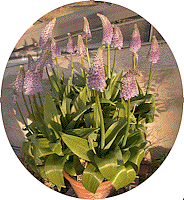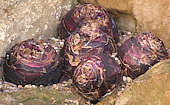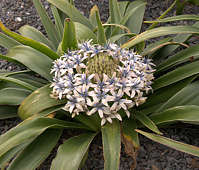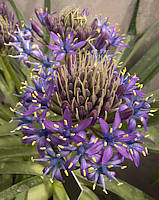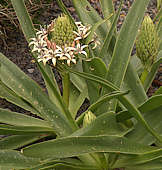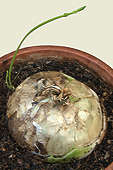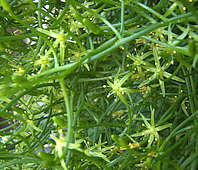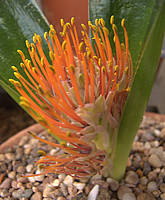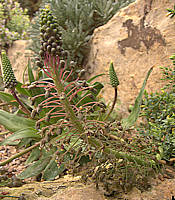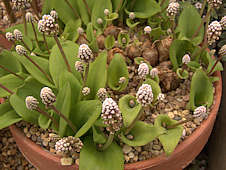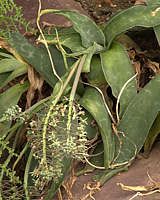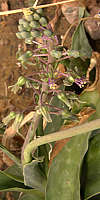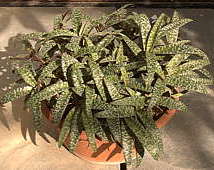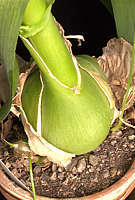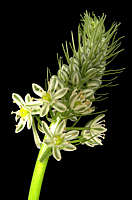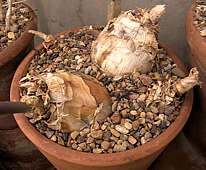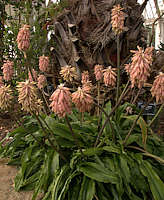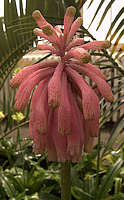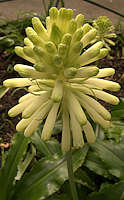Hyacinthaceae Linnaeus 1753 - Bluebell Family

The Hyacinthaceae, formerly included in the Liliaceae, is a family of around 70 genera and 1000 species of perennial herbs growing from bulbs, usually with a membraneous tunic and several bulb scales. A few species have succulent leaves. Flowers are usually radially symmetrical with six petals arranged in two whorls of three each, which may be similar or differ. The flower stalk is leafless and the flowers are always arranged in racemes, which may be compact. Fruits are dry, dehiscent capsules, often tetrahedral or at least angular.
The Hyacinthaceae are widely distributed through the temperate, subtropical and tropical parts of the world. They are well represented in Southern Africa where half of the known species may be found. The deciduous habit of many species reflects seasonal climates with seasonal fires, hot, dry or cold phases that are unfavourable for growth. The succulent bulb stores water and food until growing conditions become favourable. Evergreen species are generally from subtropical or temperate forests or grasslands.
Cultivation: Many species from the Hyacinthaceae are cultivated as Spring or early Summer-flowering ornamentals. The family includes both cool and warm weather growers. If plants become dormant and lose their leaves, watering should be reduced. However most species like a little water all the year round, and more with a little added fertiliser when in active growth. Some species should have their bulbs buried, while others such as Bowiea are best grown with the bulb on the surface of the soil. The Hyacinthaceae are often excluded from the succulent plant showbench but several choice species shown here are worth growing.
Some species of Drimia, Orntihogalum and Bowiea volubilis are very poisonous, may cause loss of livestock and definitely shouldn't be eaten.
|
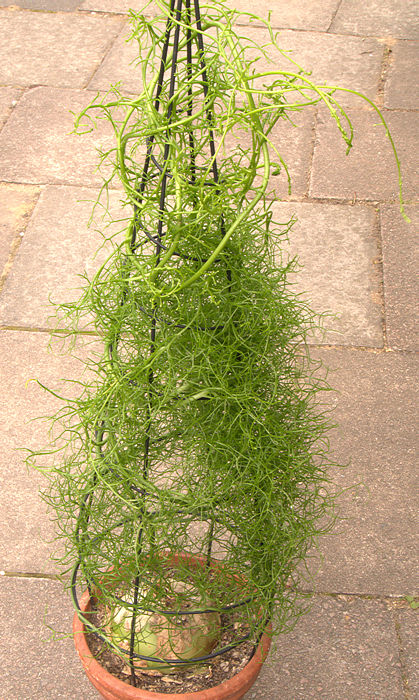 |
Bowiea Harvey 1867
Named for: James Bowie (1789-1869) British plant collector for Kew
The monotypic genus Bowiea contains Bowiea volubilis.
|
Bowiea volubilis Harvey 1867 (Climbing Onion, Sea Onion, Zulu Potato)
a very large greenish South African bulb formed from many overlapping scales, the outermost drying to a papery skin. The bulb produces a deciduous twining, highly branched stem which is really a photosynthetic raceme. A couple of small vestigal leaves may be produced from the bulb, either side of the main stem, but they soon wither. Numerous small (0.4 in) yellowish star-shaped flowers are produced along the twining stem, followed by small seed pods. Mature bulbs may offset from an outer scale.
|
|
Left: Bowiea volubilis is often grown as a curiousity and is extememly tolerant of cultural conditions. It is easy to grow a 10 in or larger bulb. Plant the bulb on the surface of well-drained soil. In the interests of sanity, plant the bulb by or under a climbing frame and encourage the growing shoot to wind around it, taking great care as it is quite brittle. Alternatively, grow in a hanging basket and allow the stem to hang down. Water weekly while in growth and fertilise with high nitrogen plant food to encourage the bulb to fatten up. Withdraw water when the annual growth starts to die back, usually in the Autumn. Cut off the dead stem when it has browned, wait a few weeks, then water occasionally until a new growth appears.
Despite the common names, all parts are poisonous and should not be consumed or fed to livestock. Sometimes seen at succulent plant shows.
|
Daubenya Lindley 1835
Named for: Charles Giles Bridle Daubeny 1795-1867, Professor of Chemistry, Botany & Rural Economics, fellow of Magdalen College, Oxford.
This genus used to be regarded as monotypic for Dubenya aurea, but recent revisions have expanded it to include 8 species, including some formerly grouped with Massonia.
|
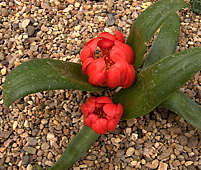 |
Dubenya aurea Lindley 1813
has broad prostrate leaves with some longitudinal striation and yellow flowers.
Left: Dubenya aurea var. coccinea Marloth 1922
has red flowers.
Native to the Roggeveld of South Africa.
|
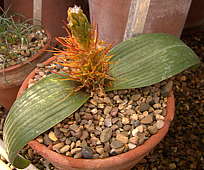
|
Daubenya marginata Manning & van der Merwe 2002
Syn. Massonia marginata Willdenow 1843
Massonia marginata has broad prostrate leaves with prominent longitudinal grooves. The red flower cluster in the middle of the two leaves has prominent orange stamens.
Native to clay soils in the Roggeveld plateau in the Eastern Cape and to the Northwestern Karoo.
|
|
Daubenya zeyheri (Kunth) J.C.Manning & A.M.van der Merwe 2002
Syn. Massonia zeyheri Kunth 1843
Named for: German naturalist Carl Zeyher (1799-1858)
The dense cluster of flowers with prominent orange stamens sits between a pair of glossy, prostrate, longitudinally-grooved leaves. The base of each orange stamen is distinctively coloured purple, reflected by a pool of nectar which is attractive to sunbirds.
Native to coastal sandy soils of the South-Western Cape of South Africa.
|
Lachenalia Murray 1784 (Cape Cowslip)
Named for: Werner de Lachenal (1739 - 1800) Swiss Professor of Botany
Lachenalia is a genus of around 115 species of choice bulbs from Southern Africa of which 80 are found in the South African Cape. Most species are Winter growers from Winter rainfall areas and are dormant during the summer. The small bulbs often offset by forming small bulbils at their base.
|

|
Lachenalia aloides (Linnaeus fils.) Engler 1899
a popular, colourful species from the South African Cape distributed as far North as Worcester. The leaves are usually marked with purple blotches. Several varieties have been described. This species has been used in hybridisation.
|
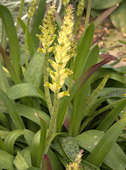
|
Lachenalia arbuthnotiae WF Barker 1984
native to the Cape flats, but less common than formerly. Leaves are marked with purple spots. The sweetly-scented, yellow flowers have greenish tips to their petals.
|

|
Lachenalia contaminata Aiton 1789 (Wild Hyacinth, Groenviooltjie)
the numerous grass-like leaves with channelled upper surfaces distinguish it from the similar L. bachmannii which has only two leaves. This species is widespread throughout the South-Western Cape.
|
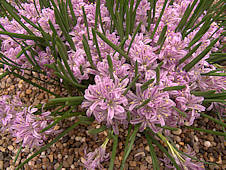
|
Lachenalia corymbosa (Linnaeus) J.C.Manning & Goldblatt 2004
|
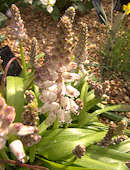
|
Lachenalia latimerae WF Barker 1979
|

|
Lachenalia longebracteata Phillips 1931
|
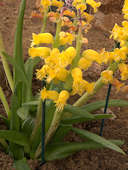
|
Lachenalia mathewsii WF Barker 1931
|

|
Lachenalia orchioides (Linnaeus) Aiton 1789
|
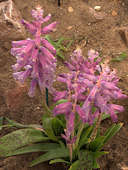
|
Labelled as Lachenalia orthopetala Jacquin 1791
which should have grass-like leaves and upward-facing white flowers with magenta markings or stripe, but probably a magenta form of the normally-red L. bulbifera Engler 1899
or a hybrid.
|

|
Lachenalia paucifolia (W.F.Barker) J.C.Manning & Goldblatt 2004
|
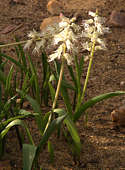
|
Lachenalia pustulata Jacquin 1791
a plant of the South-Western Cape, flowering in late Summer to early Autumn. The lanceolate leaves may be smooth or pustulate as the species name implies. The bell-shaped flowers in shades of cream, pink or blue are carried on long pedicels. Anthers are exserted.
|

|
Lachenalia rosea Andrews 1803
a species from the Cape Peninsula and further North. The flowers vary somewhat in colour, but typically as shown.
|
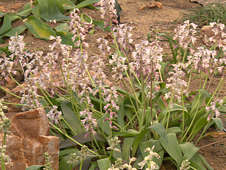
|
Lachenalia unicolor Jacquin 1797
is a plant of the Bokkeveld Mountains of South Africa, flowering in early Autumn. The inflorescence is typically a spike of many tubular brightly coloured flowers. The flowers on long pedicels may be cream, and shades of pink to purple and blue with green or purple markings. Anthers are exserted.
|

|
Lachenalia viridiflora WF Barker 1972
a rare species from a very limited range on the Western Cape, but fairly common in cultivation.
|
Ledebouria Roth 1821
Ledebouria is a small genus of geophytic bulbs closely related to Scilla but with mottled leaves and an inflorescence arising from the leaf axils. The genus is distributed across sub-Saharan Africa, Madagascar and India.
The genus Drimiopsis was recently merged into Ledebouria (Manning & Goldblatt 2004).
|
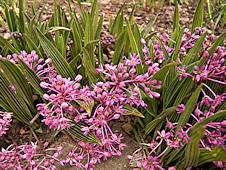 |
Ledebouria cooperii Jessop 1970 Syn. Scilla adlamii Baker 1891 (Zebra Squill)
This small bulb produces olive-green lanceolate leaves with dark purple longitudinal stripes. The inflorescence is a cluster of many shocking-pink flowers on long petioles at the end of the flower stem.
Native to grassland of Eastern South Africa.
|
|
Ledebouria ovalifolia (Schrad.) Jessop 1970
Syn. Drimia lanceolata Schrader 1827
Distributed from the Western Cape to the South-Eastern Cape, often among limestone rocks.
|
Massonia Thunberg 1780 (Hedgehog Lily)
Named for: Francis Masson (1741-1805) Scottish botanist
includes up to 14 species of choice winter-growing bulbs from arid parts of Southern Africa. All species have just 2 wide prostrate leaves which may have marked, pustulate or hairy to varying extents. Most species have scented shaving-brush like flowers with prominent stamens, produced from the centre of the leaves. Massonia jasminiflora has tubular pure white flowers with folded-back petals and exerted white stamens tipped with dark pollen.
As the globular Massonia bulbs don't usually offset, they are best propagated from seed. The soil should be very free-draining, lime-free and slightly acidic. |
| |
Massonia bifolia - see below under Whiteheadia
|
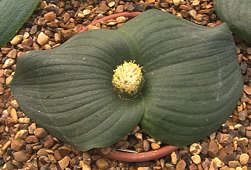
|
Massonia depressa Maarten Houttuyn 1780
is noteworthy for the yeasty perfume of its flowers, which are pollinated by gerbils and other rodents, attracted to a copious supply of viscous nectar. The large flat leaves may be spotted or have reddened leaf margins.
It is native to winter rainfall regions of the South African Cape and Namaqualand, a guide to watering in cultivation.
Photographed in the Alpine House, Royal Botanic Gardens, Kew.
|
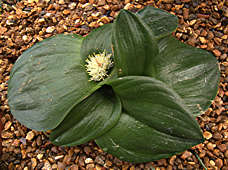
|
Massonia echinata Linnaeus fils. 1781
from winter rainfall regions of the South African Cape has sweetly scented flowers, with shorter filaments that M. pustulata. The leaves may be smooth, pustulate or echinate.
|
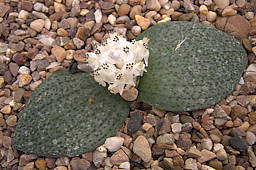
|
Massonia jasminiflora Burchell ex Baker 1870
The upper greyish leaf surface is pustulate. The cluster of white jasmine-scented flowers is atypical for this genus with recurved petals surrounding the stamens.
|
| |
Massonia marginata - see above under Daubenya
|
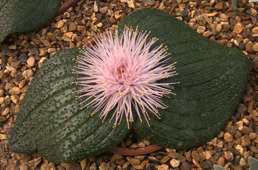
|
Massonia pustulata Jacquin 1791
is a striking species with rose-scented, white to pink shaving brush flowers of long stamen filaments, offset by pustulate green to purple or purple-streaked leaves. Most species of Massonia are pollinated by bees and butterflies.
Found in sandy soils of the Western Cape, Namaqualand and the Karoo. The plants are drought tolerant and said to be cold hardy in dry conditions.
|
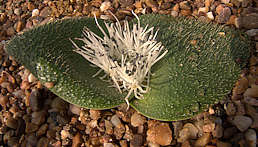
|
Massonia pygmaea von Schlechtendal ex Kunth 1843
The upper surface of the large green leaves are furnished with pustules and hairs. The inflorescence is a white shaving brush of stamens with grey anthers.
Native to high mountains of the Cedarberg and Kamiesberg.
|
Whiteheadia Harvey 1868 (Pagoda Lily)
Named for: Reverend Henry Whitehead (1817 - 1884) Anglican missionary.
A monotypic genus, occupied by Whiteheadia bifolia, recently moved into Massonia.
|
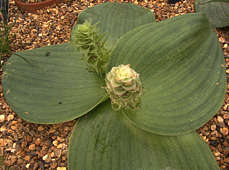
|
Massonia bifolia Manning & Goldblatt 2004
Syn. Whiteheadia bifolia (Jacquin) Baker 1873, Eucomis bifolia Jacquin 1790
has a very different inflorescence to other species of Massonia, but may appeal to those attracted to the unusual. The inflorescence has a sour perfume and is produced in the middle of two large eliptical leaves. The robust cluster of green flowers within prominent green bracts has a sculpted appearance.
This is a plant from arid winter rainfall areas of Southern Namibia, Namaqualand and the Western Cape, growing in crevices which provide a protective microclimate and conserve moisture. It is reported to be rodent-pollinated.
|
Ornithogalum Linnaeus 1753
Ornithogalum is a large genus of small bulbs, with at least 200 species from Southern Eurasia and Southern Africa. More than half of the species are native to South Africa. Leaves are narrow and the inflorescence is usually a cluster or spike of star-shaped, white or yellow to orange-red, silky flowers with 6 petals and petaloid sepals. The seeds are flattened, but without wings.
While Southern European species are frost hardy, those from Southern Africa are tender, usually winter growers. Numerous species are worth growing. A few of the hardy European species spread rapidly in the garden, but many are desirable plants.
Many Ornithogalum bulbs are poisonous due to toxic cardenolids, and cause loss of livestock. A few species are reported as edible when cooked.
|
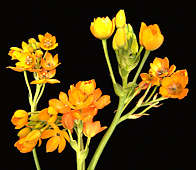
|
Ornithogalum dubium Jacquin 1777 (Snake Flower)
A perrennial bulb from the South-Western Cape Province of South Africa. The 4 in lanceolate leaves have a ciliate margin. The inflorescence in early Spring is a spheroidal raceme of up to 25 orange, red, yellow or rarely white flowers, often with a brownish or greenish center. This is one of the few species in this genus with brightly coloured flowers.

Not frost hardy but excellent for a cold alpine house although bulbs have a habit of becoming dormant. Needs a dry period after flowering. Cut flowers are long-lived in a vase. All parts are poisonous.
|
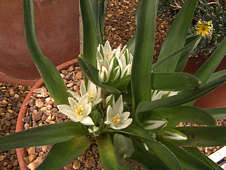 |
Ornithogalum lanceolatum Labillardière 1812 (Star of Bethlehem)
is a small plant from Palestine. Clustered white flowers are hidden among tapering green leaves. Petals may have fine green stripes on their inner surface and there is a wide band on the outer three petals.
The same common name is applied to several dissimilar species. Not frost hardy but excellent for a cold alpine house.
|
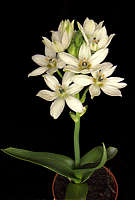 |
Ornithogalum thyrsoides Jacquin 1776 (Star of Bethlehem, tjienkerientjee)
These winter-growing bubs produce soft succulent lanceolate leaves which wither after flowering in the Spring. The inflorescence is a raceme of white star-like flowers with a darker yellow-brown centre and golden-yellow stamens.
Native to the Western South African Cape and also naturalised in Western Australia. The bulbs are cultivated for their long-lasting flowers.
|
Urginea Steinheil 1834
Bulbs from Africa and the Mediterranean, usually with white to yellow or pale pink flowers. This genus has been merged into Drimia by some authors.
|
|
Urginea maritima Baker 1873 Syn. Drimia maritima Stearn. 1978 (Sea Onion)
The large bulbs with papery tunics send up a tall inflorescence with many small white flowers along its length, usually during late Summer. The large glaucous green leaves generally appear after flowering, forming a tight cluster that dies back before the next flowering. A varieiy 'rubra' with reddish flowers is usually found further inland than the more common white-flowered form.
Native to coastal regions of the Mediterranean and widely cultivated. The bulbs should be considered poisonous although they have been used medicinally as a heart stimulant and diuretic. The juice may blister the skin.
|
Veltheimia Gleditsch 1771 (Sand Lilies)
Named for: August Ferdinand Graf von Veltheim (1741-1801).
This genus consists of two similar species of large globular bulbs producing lancolate, persistent green leaves and striking dense Aloe-like racemes of tubular pink flowers.
|
|
Veltheimia bracteata Harvey ex Baker 1870 Syn. V. viridifolia Jacquin 1797
The large bulbs develop papery outer tunics of old, dried scales. They produce a dense 2 ft raceme of many tubular pink flowers, speckled to a variable extent with yellow green towards their tips and with no discernable perfume, in late Winter and Spring and occasionally at other times.
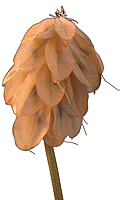 The flowers appear to be self fertile and even indoors are followed by large three-winged papery capsules containing two black seeds per locule. The glossy lanceolate leaves, with undulate margins and a central channel, persist through the year or may be deciduous in adverse conditions.
The flowers appear to be self fertile and even indoors are followed by large three-winged papery capsules containing two black seeds per locule. The glossy lanceolate leaves, with undulate margins and a central channel, persist through the year or may be deciduous in adverse conditions.
Native to forests and coastal scrub of the Eastern South African Cape where it attracts sunbirds.
Cultivation is easy as these bulbs are amazingly tolerant and flower reliably at least once a year. The bulbs should be planted on the surface of the soil with just the base and roots buried and they will clump up with time. Water throughout the year with a little fertiliser after the Spring flowering to plump up the bulbs. I usually reduce watering in late Summer and Autumn, but even so the leaves are persistent.
Veltheimia bracteata is the most common species in cultivation as it will flower in light shade. Various selected cultivars may be seen, including this pale yellow form.
|
 |
Veltheimia capensis De Candolle 1807
The large bulbs produce a dense raceme of tubular pink flowers up to 2 ft tall, in Autumn and early Winter, often before the appearance of the leaves. The blue-green lanceolate leaves, with undulate margins and a central channel are deciduous. They become greener and laxer when grown in light shade, as was this plant.
Native to Western South African and Namibia. Needs full sun to flower well. Water should be withdrawn during the Summer resting period.
|

















